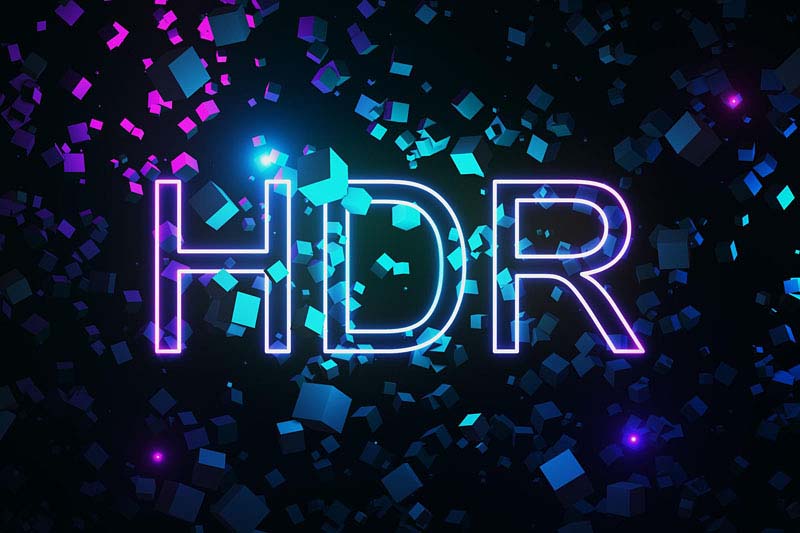HDR screens are types of screens that show images with accurate colors and good exposures and contrasts. A screen must meet key requirements set by certifying groups like VESA to be HDR. After getting certified, a product can be marketed as an HDR display.
Even though HDR logos and markings can help you find an HDR display quickly, these logos alone are often not enough to tell if a screen can show great images. Here are five HDR specs you should look at to ensure you get a screen that can handle HDR.
Color Gamut
A color gamut is the scope of colors that a screen can show. The color space that HDR displays use is called Rec.2020. This color space covers 75.8% of the CIE 1931 color space, made up of the theoretical colors that the human eye can see.
This is a big improvement over the sRGB and Rec.709 color spaces used in SDR displays. The picture above shows that Rec. 2020 can show more colors than Rec. 709. People often think that HDR displays can show the Rec. 2020 color gamut, but some HDR-certified showcases only show the sRGB color gamut.
To ensure your screen can handle HDR, look at the specs and search for Rec. 2020 or BT. 2020. If the specs don’t say the color gamut, your best bet is to buy an HDR screen from a well-known brand and stay away from cheap displays from businesses you’ve never heard of.
Color Depth
In contrast to the human eye, which observes light frequencies (colors) analogously, digital displays must be told in numbers what shade of a color to show. Color depth or bit depth is a way to discuss how the color changes from one point to another. The more bits a screen has, the more different shades of color it can show.
If the color depth is low, there will be color gradients, which cause bands. HDR screens will have between 8 and 12 colors. A regular SDR display can show up to 16 million colors, so an 8-bit color depth isn’t much of an upgrade. A 10-bit screen can show up to 1.07 billion colors, and a 12-bit screen can show more than 68 billion colors!
Since the human brain can only see a limited number of colors, the visual differences between a 10-bit and a 12-bit screen are small or not noticeable. So, a 10-bit display is all you require to watch HDR movies on the finest streaming platforms unless you want to edit 12-bit videos or make your display future-proof.
Peak Brightness
Colors are often shown as 2D pictures showing all the colors shown on a screen. Color spaces are three-dimensional. The third dimension shows the brightness of a color. The nicer your screen can get, the brighter the colors it can show, and the easier it is to see what’s on your screen in a bright room.
The peak brightness also affects the contrast and screen contrast slightly. The brightness of digital displays is measured in nits or candelas per meter squared (cd/m2). The lowest brightness for an HDR screen is 400 nits (400 cd/m2), and the highest is 4,000 nits (4,000 cd/m2).
In general, the brighter a screen is, the better it is. To ensure you get an HDR display with good contrast and dynamic range, you should also consider the screen’s contrast ratio and the type of dimming or backlight technology it uses.
Contrast Ratio
The contrast ratio distinguishes between the screen’s brightest white and the darkest black. Peak brightness is how bright a screen can get. A screen with a better contrast ratio can show high-contrast scenes like people standing before a sunset, city lighting at night, and explosions in a dark room more realistically.
A screen with a low contrast ratio could make colors look washed out and blurry in bright and dark scenes. A contrast of 3,000:1 would be a good place to start for displays with TN, VA, or IPS panels. RATINGS says that a better contrast ratio for TN, VA, and IPS displays would start at 3,000:1.
Most of the time, a higher dynamic range means a higher contrast ratio. It would be best if you also kept in mind that as contrast ratios get higher, there is a bell curve or a diminishing return. So, you’d want a contrast ratio of at least 3,000:1, but it would be best to find one with a higher ratio, like 200,000:1, or even those with an infinite number of ratios.
Local Dimming
How bright and dark a screen can get depends on its contrast ratio. The problem is that it doesn’t tell us much about how a display is lit. One of the important parts of HDR is local dimming. Local dimming is the capacity of a display to make a certain area or zone of the screen less bright.
A display with low-key lighting can turn off the lights in hundreds of spots on the screen, making the contrast much better. Without local dimming, a typical TV or monitor with an edge-lit screen would only have 1 to 16 dimming zones. Most HDR displays need local dimming, but some, like VESA’s DisplayHDR 400, don’t.
So, to ensure you get a good HDR screen, look for “Local Dimming” or “Full Array Backlight” in the screen’s specs, or get an OLED display. OLED panels are different from TN, VA, and IPS LED panels because they don’t use a backlight to light up their pixels.
Instead, OLED consists of thin semiconductor sheets made of carbon to make light. This means that OLED screens can have a contrast ratio of 1 to 1 and as many local dimming zones as the number of pixels on the screen.
The best contrast ratio is found on an OLED HDR screen. But you might want to choose a clear display instead for two reasons. The first is that OLEDs aren’t cheap. The main reason is that even the brightest OLED screens only have a peak brightness of about 700 nits.
So, if you want to use your screen in a room with a lot of light, an OLED screen may not be vibrant enough to avoid glare. You could also get a QD-OLED TV, which gives you the greatest of both worlds: deep, rich blacks and clear, brilliant whites.





